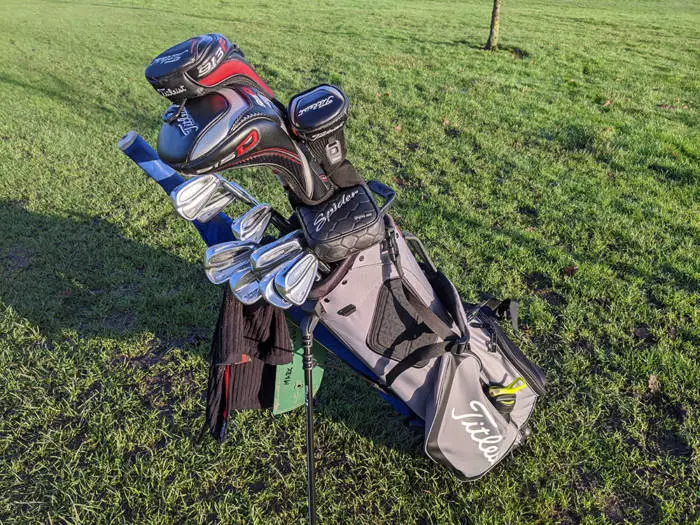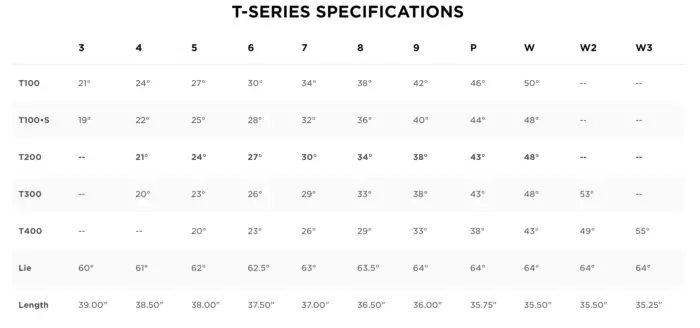What Degree of Loft Should Be On Your Golf Clubs?
Golf clubs may not look it, but they are extremely fine tuned engineering machines. Golf club manufacturers spend millions on R&D each year in search of the 1% gains that will make their clubs a little better.
They have very precise manufacturing processes to ensure each club is produced as expected, and one element that falls into that is the loft of the golf club.
When we talk about the loft on a golf club, we’re referring to the angle created between the ground and the clubface of the golf club.

Each golf club in your bag should have a different loft. The loft ultimately influences the distance the ball travels, the height of the flight and the spin on the ball. All pretty key factors when deciding which club to use on the golf course.
Generally speaking, the lower the loft on a golf club, the further the ball will travel. The higher the loft, the higher the golf ball will fly in the air with a higher rate of spin. Most golf clubs will have something between a 8.5 degree and 60 degree loft.
What are the standard lofts on golf clubs?
Before we get into the specifics of the lofts on each club, it’s worth noting that there is no official degree of loft associated with each type of club.
In fact, in terms of woods, these days they are usually sold with changeable lofts so golfers can change the loft to suit their swing, conditions of the course they are playing on and generally achieve the flight they are looking for.
When it comes to irons, each club manufacturer will have a different loft for each type of club. Some manufactures may even have different lofts between their different sets depending on whether these are game improver irons or irons aimed at low handicappers.
For example, there’s up to 7 degrees of difference between the loft on a 5 iron within the Titleist range.

To make things more complicated, as the average golfer has spent the past couple of decades searching for more distance, golf club manufactures have altered the lofts on their golf irons. Manufactures have been gradually lowering the loft on each club so the ball travels further, when what’s really happening is golfers are using a strong version of the same iron.
That all being said, there are traditional standard parameters of lofts on golf clubs.
| Golf Club | Typical loft of club |
| Driver | 9° – 12° |
| 3 wood | 13° – 16.5° |
| 5 wood | 17° – 18° |
| Hybrid | 16° – 22° |
| 2 Iron | 18° |
| 3 Iron | 22° |
| 4 Iron | 24° |
| 5 Iron | 27° |
| 6 Iron | 31° |
| 7 Iron | 35° |
| 8 Iron | 39° |
| 9 Iron | 43° |
| Pitching wedge | 47° |
| Gap wedge | 52° |
| Sand wedge | 56° |
| Lob wedge | 60° |
| Putter | 3° – 4° |
When you compare this to the actual lofts on current manufacturer sets, you can see there is a bit of a difference.
| Golf Club | Typical Loft | Taylormade SIM Max OS Irons | Titleist T200 Irons | Mizuno MP-20 MCC | Callaway Epic Forged Irons |
| 3 Iron | 22° | – | – | – | – |
| 4 Iron | 24° | 18° | 21° | 22° | 18° |
| 5 Iron | 27° | 20° | 24° | 25° | 21° |
| 6 Iron | 31° | 23.5° | 27° | 28° | 24° |
| 7 Iron | 35° | 27° | 30° | 32° | 27° |
| 8 Iron | 39° | 31.5° | 34° | 36° | 31.5° |
| 9 Iron | 43° | 36.5° | 38° | 41° | 36° |
| PW | 47° | 42° | 43° | 46° | 41° |
Putter Loft
What? You didn’t know putters had loft! Well, I bet if you asked your mates, you wouldn’t be the only golfer who didn’t.
But putters traditionally actually have around 3-4 degrees of loft on them.
This is because when the golf ball is at rest on the green, the ball actually weights down slightly into the grass. The loft ensures that the ball lifts onto the green so that it rolls more effectively.
Without the loft, the ball would simply hop and skid at the start before rolling out. You may have frustratingly done this a few times on the course, which usually ends up in the ball finishing way short of the hole.
Like when buying irons, it’s well worth getting a putter fitting (after all it’s the club you use most in your bag) to see what loft is optimum for your putting stroke to get the ball rolling as soon as possible.
How do you find the loft of a golf club?
Most wedges and woods will show the degree of loft on the head of the club. However, most sets of irons don’t have this which makes it difficult to know what lofts you’re actually playing with.
The quickest way to find this out is search your set on the manufacturers website and check if the specs are listed on there.
But beware! The loft of a club can change over time due to the repetitive impact of the club on the ground.
It’s therefore worth taking your clubs to your local PGA pro who will likely have a measuring vice that can tell you the lofts and lies of all your clubs. They can also bend them back to the correct lofts for you if they have changed over time.
What is the maximum loft on a golf club?
The maximum loft is typically on a lob wedge. These are anywhere between 58 degrees up to 64 degrees.
The average pro shop will rarely stock anything above 60 degrees of loft, so finding a lob wedge with more loft than that may prove difficult, but Phil Mickelson has previously used lob wedges with up to 64 degrees of loft in the past.